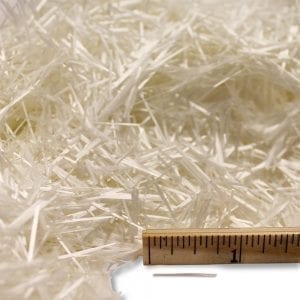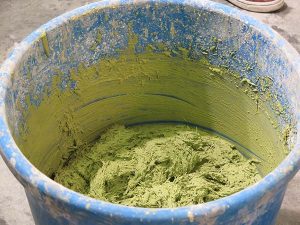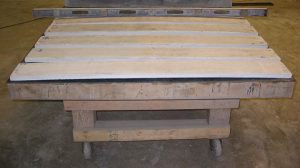GFRC is a specialized form of concrete with ingredients and proportions very different from regular concrete. It is a kind of concrete that is specially tailored to achieve a high flexural (bending) strength while keeping the mix relatively simple, economical (in both labor and materials), and easy to cast.
Materials Used in Reinforcing GFRC
Normally the chopped AR glass fibers that are mixed into the concrete are sufficient to provide all the reinforcing needed to obtain the anticipated strengths.
If additional strength is required, you can laminate woven glass mesh (scrim) within the GFRC to increase the tensile capacity, and thus the overall flexural strength where the scrim is used.
Steel rebar is not used in GFRC. I’ll explain the reason why shortly. First, some background information that will help you understand that reason.
GFRC Mix Design and Shrinkage Potential
Conventional (or regular) concrete (with rocks, sand and cement) has a mix design that differs greatly from GFRC.
Regular concrete has a high volume of hard, inert rock and sand, and a relatively low volume of cement paste binder. This combination yields a bulk material with a relatively low capacity for shrinkage.
On the other hand, GFRC has a very high volume of cement paste relative to its volume of aggregate (which is only fine sand). This is necessary to preserve workability for easy casting because of the high volume of glass fibers mixed into the material.
As a result, GFRC has a much higher shrinkage potential than conventional concrete. All concrete shrinks a bit over time as it gradually dries out, and GFRC naturally shrinks more than regular concrete does. This is important to realize and respect.
Stiffness of GFRC
A material’s tendency to stretch or shrink when it’s stressed is called its modulus of elasticity, also known as stiffness. Some materials have a low stiffness. Rubber, for instance, is very elastic and stretches and compresses a great deal. Other materials have a high stiffness. They are extremely stiff and stretch very little when stressed. Carbon fiber is an example of this.
Steel has a very high modulus (though not as high as carbon fiber), while glass (used in the glass fibers), has a modulus about 1/3 as stiff as steel.
The takeaway here is that glass stretches more than steel. Therefore glass fibers stretch more than steel fibers or rebar.
Reinforcing Boosts Tensile Strength of Concrete
A material’s modulus of elasticity is not the same as its tensile strength. Tensile strength is also an important consideration.
Regular concrete has a high compressive strength but very low tensile strength on its own. Regular concrete relies on steel reinforcing bars (rebar) to boost the tensile strength.
Concrete countertops are beams, and beams can be subjected to high tensile stresses. Steel rebar is placed in specific locations where tensile stresses are expected to be high, which is usually very close to the tensile face of the concrete slab.
Also, conventional concrete is generally cast much thicker than GFRC pieces are. Usually regular steel-reinforced concrete slabs are at least 1.5″ (roughly 38mm) thick, or thicker. This allows for placement of steel reinforcing without problems. GFRC is often half as thick, making the correct placement of steel in a mere 1/4″ (19mm) of GFRC virtually impossible.
Steel rebar is also used in conventional concrete because the bulk properties of the concrete itself have shrinkage and thermal characteristics that compliment steel.
GFRC instead relies on glass fibers mixed into it for strength. After all, it’s in the name: Glass Fiber Reinforced Concrete.
Differential Shrinkage Potential in GFRC
Because the majority of the cross-section of GFRC is basically uniform (it’s all the same glass-fiber reinforced mix), its properties are relatively uniform top to bottom (ignoring the thin face coat). Because glass fibers are mixed in, they are everywhere in the concrete, even though they’re not necessary everywhere. This makes reinforcing and casting GFRC significantly simpler and easier than steel-reinforced concrete. It also affects differential shrinkage potential, as I’ll explain now.
As GFRC shrinks, it shrinks evenly (provided it is stored and cured properly). Improperly stored GFRC panels and slabs can still warp and curl due to differential shrinkage caused by moisture imbalances between opposite faces. This is differential shrinkage due to moisture differences.
There is another way that warping/curling could occur. If a thicker section of GFRC (say 2″, or 50mm) had steel reinforcing (rebar or even masonry ladder wire) embedded in it, and that steel was (correctly) placed near the tensile face of the slab, the much higher stiffness of the steel would restrain one face of the GFRC slab, while the opposite face (without any steel in it) would be free to shrink as the concrete dried out. The result would be that the slab would curl. This is differential shrinkage due to stiffness differences.
Usually a GFRC slab doesn’t curl because of the properties of the mix (the concrete plus the glass fibers) are uniform top to bottom. But embedding steel rebar, which is much stiffer than glass, introduces the potential for differential shrinkage due to stiffness differences.
It’s for this reason that we say you can’t use steel reinforcing in GFRC.
So there you have it. You now understand how GFRC mix design affects stiffness, tensile strength and shrinkage potential, and ultimately means that steel is not a good match for GFRC.
Other Materials Safe for Reinforcing GFRC
If your project requires extra tensile capacity in a slab (over and above that which scrim can provide), then use fiberglass (or basalt) rebar in place of steel rebar. Both fiberglass and basalt rebar have published modulus values (www.fiberglassrebar.us) which are only about 20% as stiff as steel rebar. Thus, these synthetic rebar materials like fiberglass or basalt will work safely in GFRC without causing curling the way steel rebar does.
Reinforcing Placement is Still Important in GFRC
Bear in mind if you choose to use discrete pieces of reinforcing material (whether it’s steel, fiberglass, basalt or some other exotic material) in GFRC, you must still obey the rules of reinforcing placement. GFRC is still concrete, and all concrete obeys the laws of physics. You must still size and locate rebar properly regardless of the material in order to achieve the physical and structural properties your project and client requires.
More about how beams work, where the tensile stresses are in beams, and rebar size in slabs:






